

Canadian amateurs have full access to the 2200m and the to 630m bands without the need for special operating permission. In Decemebr 2009, Canadian amatuers were allowed full operating privileges on the 2200m band. In May 2014, Canadian amateurs were allowed full operating privileges on the 630m band. Canadian hams are most fortunate to be granted these two slices of the radio spectrum in which to experiment as amateurs in the U.S.A. are still working to obtain access to either of these bands. I would strongly encourage Canadian amateurs to take advantage of our good fortune and begin using these two bands as soon and as often as possible. Both bands present a wonderful opportunity for experimentation and homebrewing activities!
2200m Band
Amateurs are reminded that they are 'secondary users' of this band (135.7-137.8 kHz) and as such, are required to operate on a non-interference basis to the 'primary users'(Canadian Navy, various Hydro authorities). Extensive amateur operations across Canada during the '2200m Experimental Licensing Program' (several hundreds of hours) and for the past several years, produced no known cases of amateur interference to secondary users as well as little or no interference from the secondary users to amateur operations. Amateurs are limited to 1W E.I.R.P. on the 2200m band, more than enough power to push signals across the continent under the right propagation conditions.
630m Band
As on 2200m, amateurs are 'secondary users' of this band (472-479kHz) and as such, are required to operate on a non-interference basis to the 'primary users'. In the U.S. and in Canada, the 472-479 kHz band is part of the larger 435-495 kHz segment allocated on a primary basis to the Maritime Mobile Service and on a secondary basis for government Aeronautical Radionavigation. Amateurs are limited to 5W E.I.R.P. on the 630m band.
CW Calling Frequency On 630m
As of November, 2017, there has been discussion for a North American CW frequency region and present consensus is between 473 and 474.5 kHz ... nothing official yet.
So ... if you are anywhere between here and Ontario, and you put something together, fire off a few CW CQ's in the evening and chances are that someone might hear you out this way ... the closer you are, the better are our chances of working. As well, for greater chances of being heard, announce your activity in real time on the ON4KST 2200 / 630m chat page!
Making A Start
If you are planning on building a system for 630m, you may want to seriously consider a transverter. The simplest to build is a non-linear type, which will allow you to transmit the popular digital modes used on the band, such as WSPR and JT-9. A popular homebrew transverter is the one designed by Roger, G3XBM, details of which may be found here.
Another new transverter (from Australia) is proving to be an excellent performer. You can read a review of it here.
Any and all new activity would be a wonderful thing on our new band! If you need help or advice, I can provide that as well ... grab that soldering-iron and let's start building!
**** For the LATEST 630m NEWS from VE7 land, check my 630m blogs here ****
**** In September, 2016, I was able to work VK4YB near Brisbane, Australia on 630m, on two occassions. The mode used for our two contacts was JT-9, the 'WSPR QSO mode'. These contacts are the first ever between North America and Australia on 630m and presently also the furthest distance claimed on 475 kHz, but probably not for long! (Record broken by W7IUV in eastern Washington, once the U.S.A. got the band. I think this distance-record will continue to increase as the band becomes more populated ... however, it was fun to 'hold the record' for a few months!!). More details can be found in my blog by going here.
Mitch, VE3OT was worked on 630m CW in February ('16). As far as we know, this is the furthest 630m CW QSO in Canada.
Phil, VE3CIQ, was worked in October ('16). His signal often reaches CW levels here under good conditions.
Eden, ZF1EJ, has now been worked several times on 630m JT9 mode. His 70W signal often reaches CW levels here under good conditions.
STATION ACTIVITY LIST Who's On-the-Air? *** IF YOU ARE TRANSMIT-READY ON 630m OR 2200m, PLEASE LET ME KNOW FOR INCLUSION HERE ON THE ACTIVITY PAGE! ***
VE7BDQ - DELTA, B.C. (CN89)
John is active on both 2200m and 630m with a newly constructed transmitter capable of dual-band operation. His tx antenna is a top-loaded vertical while a loop or inverted 'L' is used for receiving.
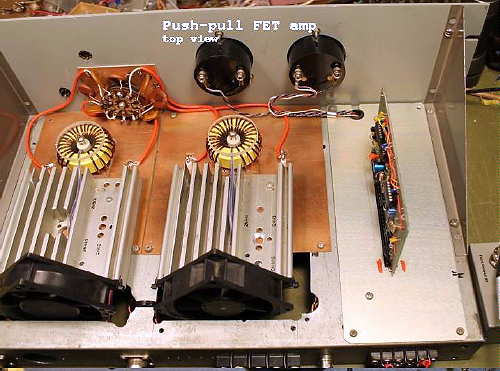
Two dual-band FET power modules are fed to the homebrew dual-band power combiners, one for 2200m and one for 630m.
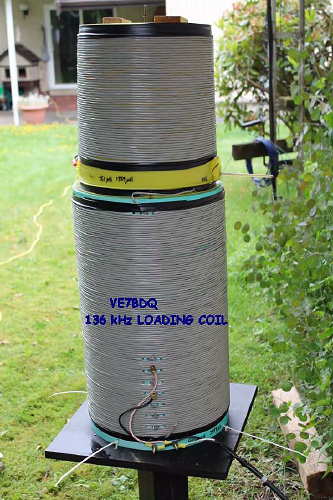

John's loading coil has been wound with flat ribbon telephone wire on a large piece of PVC water pipe as well as a small bucket.The inside of the top bucket also houses a 1mH variometer which can be tuned from the shack via an insulated rod.
Total inductance of the system is about 4mH.
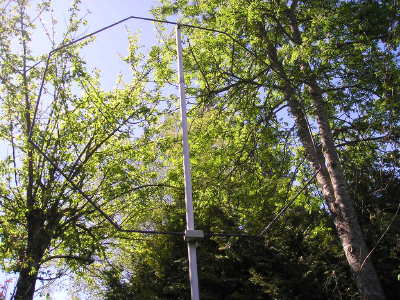
A 6' multi-turn active loop is used for receiving. The tx antenna is ~ 10m vertical with 70m of top loading, inverted 'L' style.
John has been able to copy good signals from JA7NI 2200m while his LF signals have been copied all over North America ... and on 630m as far as the Grand Caymans and Australia.
The VE7BDQ LF activities demonstrate that being located on a normal sized suburban lot should be no deterrent to getting on-the-air and enjoying what LF has to offer.
VA7JX - CAMPBELL RIVER, B.C. (CN79)
Until recently moving to a new location, with more antenna room, Jack had been active on 2200m as well as on 630m with about 100 watts. I will update Jack's informatin when he sends some pictures from the new location. He is presently building a higher powered transmitter for 630m work.
Jack's new homebrew transverter uses an IRF540.
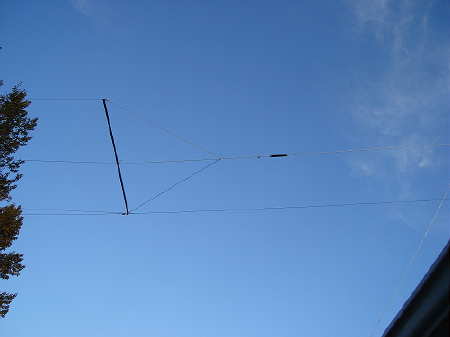
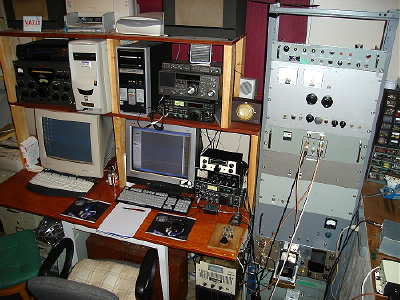
Jack's 2200m three-wire flattop along with his well-organized shack
VE7CNF - Burnaby, B.C. (CN89)
Toby is now active on 630m and 2200m in either CW or WSPR modes. His homebrew kilowatt P-P FET TX is shown below. So far he has reported blowing no FET's ... a VERY rare occurrence! Toby's WSPR signal has been widely reported over North America as well as the Grand Caymans. His best CW DX is with KH6 during a '630m crossband' event.
Toby has recently built a SSB transmitter using a unique FET 'power mixer', producing about 25W output ... and it sounds great!
You can see more of Toby's station and other helpful information at his website HERE.
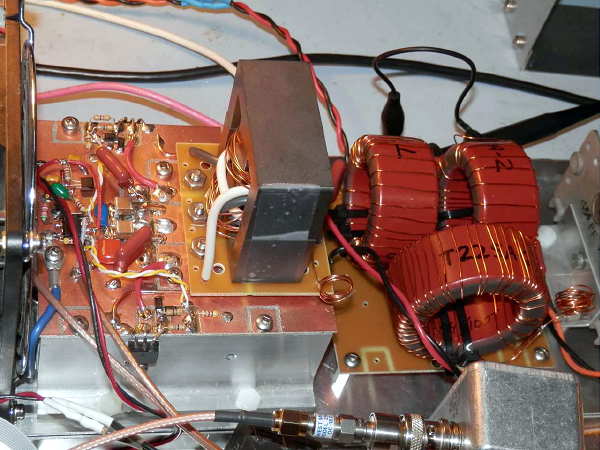
Toby's variometer consists of 4.5" and 3.5" nesting tubing at around 600uH.
VA7MM - Coquitlam, B.C. (CN89)
Mark, in Coquitlam, has recently become active on both 630m and 2200m. His present 630m transmitter is a GW3UEP design, running at the 100 watt level. His 2200m station is presently at the 1 watt level but has been loud enough over here on Mayne Island to have an enjoyable CW QSO on 136 kHz. Plans are in the works for more power on 2200m. His well-planned Marconi 'T' antenna consists of an almost 100' vertical coaxial radiator with a multi-wire flat top ... all above a system of 16 radials.
Mark has recently built a transverter obtained from John Molnar, WA3ETD. John's transverter is paired with a GW3EUP type 100W PA and is in use on both WSPR and FST4 QSO modes.
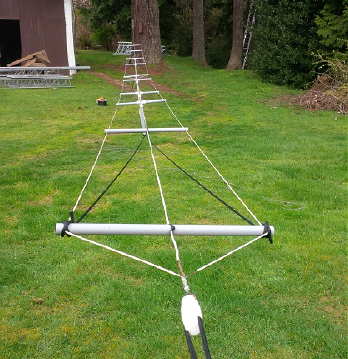
The antenna is also used on several of the higher HF bands as individual dipoles by unshorting the coaxial feedline as well as on 160m, again as a 'T' ... an extremely versatile antenna. In a well-planned design, loading coils / variometers for both the LF and MF bands use a pair of telescoping PVC tubes rather than the usual rotary style. The impedance matching ferrite transformer is mounted inside the variometer.
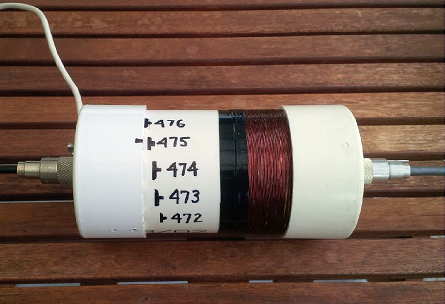
The antenna system works well and so far his best DX on 630m has been a CW crossband contact with KH6 during one of the winter '630m crossband' events.
VE7CA - North Vancouver, B.C. (CN89)
Markus, in North Vancouver, has also become available on 630m and can often be caught calling CQ on 475.0 kHz. His transmitter consists of a homebrew xvrtr and QRO amplifier.
The antenna loading coil / switching unit at VE7CA
The antenna system consists of a top-loaded vertical with the top-load being two 20 meter 'Double Zepp�s' with 75 ft feed lines on both, shorted at the bottom end.
VE3CIQ - Carleton Place, ON. (FN15)
VE3CIQ has been very active on 630m WSPR this winter ('16-'17) and puts out a good signal from a small backyard antenna system. Phil and I had a nice 630m QSO on JT9 mode earlier in October '16. Phil is available for 630m JT9 skeds and has promised some CW activity once he gets more code practice.
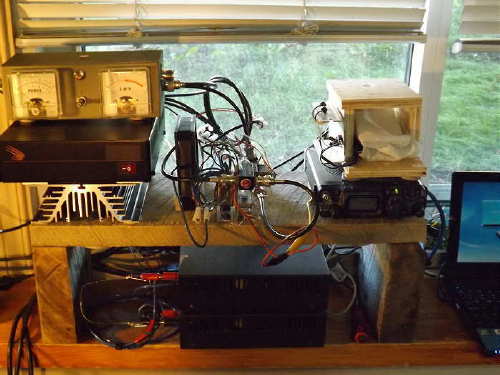
Phil's homebrew FET amplifier
Phil's antenna is an 'inverted-L' style ... 45' up to the top of a Pine tree and then a very very long sloping top hat wire, folded back on itself three times, in a zig-zag pattern. This use of linear-loading allows him to squeeze a near full 1/4 wave antenna into his suburban lot as well as to reduce the size of his loading coil inductance. His ground system consists of ~3,000' of buried radials. By all accounts, it seems to perform very well as his WSPR beacon was recently heard in Hawaii!
VE7SL - MAYNE ISLAND, B.C. (CN88)
I am also QRV but have been focusing on 630m rather than the little-used 2200m band.
See my station description here.
Previous Highlights From VE7 Land
LF history was made in the early hours of September 28th, 2010 when Scott, VE7TIL and Kuni, JA7NI completed the first Asian to North American QSO on the 2200m band! Spanning a distance of almost 7200km, the groundbreaking trans-Pacific QSO was the second longest on record. Congratulations to both Scott and Kuni for their truly inspirational work. Unfortunately Scott is no longer active on LF and his great station has been shutdown.
Here is an archival screen shot from The Alaskan Snapper screen grabber operated by Laurence, KL7L, shows a great night of action out here on the west coast as heard in Alaska.
Signals in descending order: VE7TIL (DFCW 'TIL'), VE7SL (DFCW 'SL'), JA1GCM (QRSS 'GM'), VE7BDQ (QRSS 'BDQ')
Another great 2200m screen shot recently received from Neil, WØYSE/7 in Layton Utah, shows three VE7's lighting up his receive system on the evening of January 15, 2011. Signals from VE7SL, VA7JX and VE7BDQ were all doing well over the 1200km path. Neil's receive antenna is just a small homebrew active PAØRDT mini-whip.
LF propagation was above normal on the evening of Jan 8, 2012. The screen grab shown below is from VE2IQ's excellent receive system near Ottawa. The strong 'SL' was at full power while the short keydown at the end was at just 18 watts output.
Good propagation returned on the night of January 19th, when VE1VDM in Nova Scotia captured my signal in the predawn hours.
A few evenings later, both myself and VE7BDQ, completed quick crossband QSO's with Utah when we both worked WØYSE north of Salt Lake City. This screen grab from Neil shows my QRSS3 signal sending 'R R 5NN E'. The 'E' is used as a faster way of sending 'K'.
Neil's grab of John sending his full call during his QSO with Utah
Canadians On 2200m - Historical Notes The following information, although now somewhat dated, will provide some idea of the activities undertaken during the '2200m Experimental Licensing Program' which ran for several years preceeding WRC-07. As an amateur interested in getting-on either of our two LF bands, hopefully you will find the information both helpful and inspirational!
Over the next few months, as various new stations populate the band, this information will be phased-out and updated with 'recent activity' news, notes and pictures. If you are building for LF, please send along pictures of your equipment and antenna systems for inclusion as well as to inspire others. The more interest we can all generate, the more on-air activity will result! You will find all of the links below to be up-to-date and extremely helpful if you are thinking of getting started on LF.
*********************************************************** VE3OT - Mitch Powell in London, Ontario. Presently running beacon "MP" in QRSS mode 24/7 on 137.780 kHz. Mitch is being heard well in the eastern/south-eastern USA as well as out west. Mitch has recently fired up his GØMRF amplifier into a large loop and was reported in Europe.
Mitch is planning to move to 630m in early January 2016 and will be a welcome DX target from the west coast.
VO1NA - Joe Craig in Torbay, Newfoundland. Joe is presently running the VO1NA QRSS beacon. VO1NA completed a two-way Trans-Atlantic QSO on June 12/03 when he worked MØBMU on QRSS30 mode. In early July, Joe's signal was also heard with good strength in Portugal and Germany. Joe's signal was recently heard south-east of Moscow by RN6BN in both QRSS and 5 WPM CW modes! If you are in the east, listen for Joe's signal. VO1NA runs 500 watts from a refurbished Decca transmitter into a 100m sloper. See the link below for V01NA's latest activities.
VY1JA - J. Allen in Whitehorse, Yukon Territory is now operational on 2200m, both beaconing and in listening mode. J is using a very large antenna system consisting of a 110' top loaded vertical, utilizing two 390 foot top-loading wires. In earlier tests, his low-power (50W) signal) was very good copy here on Mayne Island at 1000 miles distance. Now that he is QRO at 200W (soon to be even higher), his signal is very easy copy, even during the daytime. Our recent QRSS QSO was the first long-distance LF contact between two 2200m stations in Canada.
On the evening of September 8th, 2006, just a few minutes before midnight, J and I were able to easily work on CW for the first long distance CW QSO on LF between two Canadian stations.
Since our initial CW contact, J and I have had several pre-dawn or late evening CW ragchews on 2200m. Signal levels on several of our contacts have reached 599 levels over the 1000 mile path.
*** The first confirmed European reception of 2200m signals from western Canada took place on the night of November 21, 2006 at 0700 UTC. VY1JA's trans-Polar QRSS signal was received by Hartmut Wolff located in Germany. Thanks to the diligence of Scott's (VE7TIL) and his screen grabbing system, Hartmut's capture, shown below, was confirmed by comparing it to the screen grab captured by Scott during the same time period. Jay's beacon, shown drifting downward, had just been turned on for the evening. This reception covers a tantalizing distance of over 4300 miles and is an excellent indicator of what can be accomplished with small levels of erp, even on 2200m. Congrats to Jay, Hartmut and Scott. ***
VE7SL - Steve McDonald on Mayne Island, British Columbia.
*** The first VE7 2200m QSO was completed on July 10th 2004
between myself and Scott, VE7TIL, in Vancouver. ***
As of early December, my high-power transmitter has been completed and the antenna system has undergone extensive renovation. (see 'My 2200m Station Page').
Signal reports have been received from: Washington, Oregon, Minnesota, Oklahoma, Connecticut and Ontario. Two-way crossband work has also begun. A recent QSO with KØMVJ (Duluth, Minnesota) demonstrated the viability of that mode.
VE7TIL - Scott Tilley in Vancouver, British Columbia. Operating authority has been granted effective July 1, 2004. Scott is presently on the air with a homebrew 500W P-P FET final driven with a homebrew DDS exciter. Scott's antenna system consists of a small 3-wire flattop about 40' high. After our initial QSO, Scott's beacon signal was reported in southern Oregon, while running about 100W. VE7TIL's 500W signal has now been copied (QRSS60) regularly by Laurence, KL1X, in Oklhoma as well as in eastern Canada and the eastern U.S.A. Scott's efficent station demonstrates that even living within the noisy city, it is still possible to operate on the 2200m band!
QRSS DX Activity from my station has so far been centered upon receiving. Almost all DX work on LF utilizes the slow speed CW or QRSS mode. The most popular software for decoding QRSS signals is ARGO by I2PHD and IK2CZZ. It is freely available at various web sites for downloading (see LINKS section). ARGO is a very intuative user-friendly program and works extremely well. Accordingly, my first attempts at low frequency QRSS work were directed towards listening for signals from Larry Kayser (SK), VA3LK. Larry was on a nightly transmitting schedule in an attempt to see if his signal could be heard in New Zealand.
Here is a screen capture of Larry's 2200m QRSS signal as received on 06/23/01 at 0944 UTC.
QRSS signals are usually too weak to be actually heard by ear. ARGO allows signals buried in the noise to be 'seen' rather than 'heard'. The screen capture above clearly shows the sequence
"K V A 3 L K". The signal abruptly faded out at Larry's sunrise in the middle of the next "V".PUSHING THE BOUNDARIES... Seven days later, my overnight screen captures showed the weak signals of amateur station ZL6QH, transmitting from Quartz Hill, New Zealand on 184.4kHz. This was the first transpacific reception of LF amateur signals from New Zealand to North America, a distance of 11,715km.
ZL6QH was transmitting QRSS in the DFCW mode which meant the 'dots' were shifted in frequency slightly from the dashes. Unfortunately my receiver calibration was slightly off and I had only captured the 'dots' and missed the dashes just a few hertz lower. Subsequent transmitting tests were eagerly monitored by numerous other stations in North America and quickly confirmed that long-distance propagation was possible, even at amateur power levels. The ZL6QH signal has now been heard as far back as VE1 land!
My next attempt at seeing the ZL6QH signal was in September of 2001. This time I made sure my receiver calibration was set correctly. Note the abrupt fade-out at my local sunrise. ZL6QH was sending the letter 'Q', with the lower signal representing dashes, the higher one dots. Note that the two dashes are run together, appearing as one long dash in order to conserve time.

The best reception of ZL6QH on 137kHz was obtained in December of 2002. Almost four hours of continuous "Q's" were noted until the sunrise fade-out shortly after this screen shot. Note from the ARGO calibration scale that the two signals are only .4 Hz apart.
LOWFER DX... A number of good test targets are available within the U.S.A. on the 160-190 kHz LOWFER band. They are exceptionally challenging and a good test for your receiving system as lowfer power is restricted to 1 watt DC INPUT and antenna sizes are severely limited.
The night of January 03, 2002 provided some exceptional propagation on the LF LOWFER band. The 1 watt QRSS signals of LOWFERS "LEK" and "BRO", both located in Minnesota, were noted with strong signals around local midnight. The two stations were transmitting .5 Hz away from each other.
Earlier in the evening around 2100 hours, the skip was much longer and LOWFER "NC" in North Carolina was also seen briefly. Dexter's signal was .5 Hz above the "Minnesotta Twins".
* * * ALASKA ON 2200m !* * * Unfortuantely, Laurence, KL1X (near Anchorage), has now closed down his LF station and moved to Oklahoma but his activity from KL7 land created a lot of interest. Here is a screen capture of the first really good signals received from Laurence (August 17th, 2003) after listening nightly for about one week. Laurence's signal was strong, all night long, starting shortly after local sunset until shortly before sunrise. KL1X was transmitting in the QRSS60 (60 second dots) mode. The distance is approximately 2200km. Hopefully we will soon see Laurence active again from the southern U.S.
Checking the North American 'Watering Hole' Almost all normal night-to-night activity in North America takes place within the 'watering hole' section of 2200m...a 5 Hz section of the band from 137.775 kHz - 137.780 kHz. On nights of above normal propagation, several amateur or Part 5 (U.S.) signals, along with numerous Loran Line* signals can be seen. Here is an Argo screen capture taken on a March afternoon showing several Loran Line signals normally heard on Mayne Island. Not only can they be used to check propagation but also to check your system frequency calibration.
****** Please note that as of August, 2010, all of the U.S. and Canadian Loran stations have shut down so these (once) very handy reference signals are no longer available for calibration purposes! However, amateur activities are still centered in or around the 'watering hole' (above). The best way to now calibrate your ARGO receiving system is to listen for an amateur beacon on a known frequency or for one of the larger commercial stations also operating near the 2200m band. Once any accuracy errors in your receive system oscillators are known, this correction factor can be easily applied to the 2200m band.
L.F. LINKS If you are interested in learning more about constructing a station for 2200m or for 630m, there is a huge amount of practical information available on the following web sites.
THE WORLD OF L.F. - A fantastic site by G3YXM. Get the latest LF news, getting-on the air, tx circuits etc. Be sure to visit the excellent photo'gallery'of European LF stations. It's hard not to get inspired after seeing some of these fine 136kHz stations!
DF3LP's L.F. INFO - A simple 100W LF transmitter for 136kHz using inexpensive power FETs.
DF3LP's L.F. INFO - A simple receiving loop for 137kHz.
136kHz AT G3YMC - A good source of 'hands-on' information.
ON7YD - AMATEUR RADIO ON LONGWAVE - Probably one of the best sources of practical construction info. It's all here!
DK8KW LONGWAVE INFORMATION PAGE - Lots of good links.
136kHz EQUIPMENT -Tx, rx, antenna and variometer info from IK2PII.
FIRST TRANS-ATLANTIC LF QSO - Read about the first LF TA contact along with station details and pictures!
GØMRF PROJECTS - Lots of good stuff on tx, rx, amplifiers etc.
QRSS AND YOU - Clint Turner's excellent QRSS page. A must see!
LONG WAVE CLUB of AMERICA - Get the latest LF news here.
DIGITAL SITE of ALBERTO (I2PHD) and VITTORIO (IK2CZZ) - Download the latest versions of ARGO, SPECTRAN and others.
AMRAD L.F. PAGE - Equipment details.
The RSGB L.F. REFLECTOR - A very busy interactive LF reflector; both European and North American.
W4DEX ON THE WWW - LOWFER 'NC'. Station description. LF/MF information.

